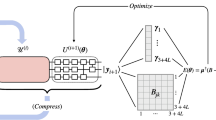Abstract
In this paper we prove the persistence of invariant tori of analytic reversible systems under Brjuno–Rüssmann’s non-resonant condition by an improved KAM iteration, but the frequency may undergo some drift. Furthermore, if the frequency mapping has nonzero Brouwer’s topological degree, then the invariant torus with prescribed frequency can persist. In the proof we propose a new method of KAM iteration for reversible systems, containing an artificial parameter \(q, 0< q <1, \) which makes the steps of KAM iteration infinitely small in the speed of the function \(q^{n}\epsilon \) rather than super exponential function \(\epsilon ^{\lambda ^{n}}, 1<\lambda <2\).
Similar content being viewed by others
References
Arnold, V.I.: Reversible systems. In: Nonlinear and Turbulent Processes in Physics, vol. 3 (Kiev, 1983), pp. 1161–1174. Harwood Academic Publishers, Chur (1984)
Broer, H.W., Huitema, G.B., Sevryuk, M.B.: Quasi-Periodic Motions in families of Dynamical Systems, Order Amidst Chaos, Lecture Notes in Mathematics, vol. 1645. Springer, Berlin (1996)
Broer, H.W., Huitema, G.B.: Unfoldings of quasi-periodic tori in reversible systems. J. Dyn. Differ. Equ. 7, 191–212 (1995)
Broer, H.W., Hoo, J., Naudot, V.: Normal linear stability of quasi-periodic tori. J. Differ. Equ. 232, 355–418 (2007)
Broer, H.W., Ciocci, M.C., Hanßmann, H., Vanderbauwhede, A.: Quasi-periodic stability of normally resonant tori. Phys. D 238, 309–318 (2009)
Liu, B.: On lower diemnsional invariant tori in reversible systems. J. Differ. Equ. 176, 158–194 (2001)
Pöschel, J.: KAM à la R. Regul. Chaotic Dyn. 16, 17–23 (2011)
Parasyuk, I.O.: Conservation of quasi-periodic motion in reversible multifrequency systems. Dokl. Akad. Nauk Ukrain. SSR. Ser. A 9, 19–22 (1982)
Popov, G.: KAM theorem for Gevrey Hamiltonians. Ergod. Theory Dynam. Syst. 24, 1753–1786 (2004)
Rüssmann, H.: Invariant tori in non-degenerate nearly integrable Hamiltonian systems. Regul. Chaotic Dyn. 6, 119–204 (2001)
Rüssmann, H.: KAM iteration with nearly infinitely small steps in dynamical systems of polynomial character. Discrete Contin. Dyn. Syst. Ser. S 3, 683–718 (2010)
Sevryuk, M.B.: Reversible Systems, Lecture Notes in Mathematics, vol. 1211. Springer, Berlin (1986)
Sevryuk, M.B.: Invariant m-dimensional tori of reversible systems with phase space of dimension greater than 2m. J. Soviet Math. 51, 2374–2386 (1990)
Sevryuk, M.B.: Lower-dimensional tori in reversible systems. Chaos 1, 160–167 (1991)
Sevryuk, M.B.: The iteration-approximation decoupling in the reversible KAM theory. Chaos 5, 552–565 (1995)
Sevryuk, M.B.: KAM stable Hamiltonians. J. Dyna. Control Syst. 1, 351–366 (1995)
Sevryuk, M.B.: The reversible context 2 in KAM theory: the first steps. Regul. Chaotic Dyn. 16, 24–38 (2011)
Sevryuk, M.B.: KAM theory for lower dimensional tori within the reversible context 2. Mosc. Math. J. 12, 435–455 (2012)
Wagener, F.: A note on Gevrey regular KAM theory and the inverse approximation lemma. Dyn. Syst. 18, 159–163 (2003)
Wei, B.: Perturbations of lower dimensional tori in the resonant zone for reversible systems. J. Math. Anal. Appl. 253, 558–577 (2001)
Wang, X., Xu, J.: Gevery smoothness of invariant tori for analytic reversible systems under Rüssmann’s non-degeneracy condition. Discrete Contin. Dyn. Syst. Ser. A 25, 701–718 (2009)
Wang, X., Xu, J., Zhang, D.: Persistence of lower dimensional elliptic invariant tori for a class of nearly integrable reversible systems. Discrete Contin. Dyn. Syst. Ser. B 14, 1237–1249 (2010)
Wang, X., Zhang, D., Xu, J.: Persistence of lower dimensional tori for a class of nearly integrable reversible systems. Acta Appl. Math. 115, 193–207 (2011)
Wang, X., Xu, J., Zhang, D.: Degenerate lower dimensional tori in reversible systems. J. Math. Anal. Appl. 387, 776–790 (2012)
Wang, X., Xu, J., Zhang, D.: On the persistence of degenerate lower dimensional tori in reversible systems. Ergod. Theory Dyn. Syst. 35, 2311–2333 (2015)
Xu, J., You, J., Qiu, Q.: Invariant tori of nearly integrable Hamiltonian systems with degeneracy. M. Z. 226, 375–386 (1997)
Xu, J.: Normal form of reversible systems and persistence of lower dimensional tori under weaker non-resonance conditions. SIAM J. Math. Anal. 36, 233–255 (2004)
Xu, J., You, J.: Gevrey smoothness of invariant tori for analytic nearly integrable Hamiltonian systems under Rüssmann’s non-degeneracy condition. J. Differ. Equ. 235, 609–622 (2007)
Zhang, D., Xu, J.: On elliptic lower dimensional tori for Gevrey-smooth Hamiltonian systems under Rüssmann’s non-degeneracy condition. Discrete Contin. Dyn. Syst. Ser. A 16, 635–655 (2006)
Zhang, D., Xu, J.: Gevrey-smoothness of elliptic lower-dimensional invariant tori in Hamiltonian systems under Rüssmann’s non-degeneracy condition. J. Math. Anal. Appl. 322, 293–312 (2006)
Author information
Authors and Affiliations
Corresponding author
Additional information
The work was supported by the National Natural Science Foundation of China (11001048) (11371090) (11501234).
Appendix
Appendix
In this section we formulate some lemmas which have been used in the previous section.
Lemma 2.4
Let \(s_{+}=s-\sigma , r_{+}=\eta r,\) and
Suppose that \(\Vert h\Vert _{s,r}\le 2\Lambda (\tau )\sigma \alpha ^{-1}\epsilon , \) \(|\hat{\omega }|_{s_{+},r_{+}}\le a\epsilon ,\) where \(\epsilon <\frac{b^{2}\alpha ^{2} }{4\Lambda ^{2}(\tau )}.\) Then we have
Proof
Lemma 2.5
Let \(s_{+}=s-\sigma , r_{+}=\eta r,\) and
Suppose that \(\Vert g(x)\Vert _{s,r}\le 2\Lambda (\tau )\sigma \alpha ^{-1}\epsilon , \) \(\Vert f^{1}_{+}\Vert _{s_{+},r_{+}}\le 2((1-a)+b+ab)\epsilon , \) \(|\hat{\omega }|_{s_{+},r_{+}}\le a\epsilon ,\) where \(\epsilon <\frac{b^{2}\alpha ^{2} }{4\Lambda ^{2}(\tau )}.\) Then we have
Proof
Rights and permissions
About this article
Cite this article
Zhang, D., Xu, J. & Wang, X. A New KAM Iteration with Nearly Infinitely Small Steps in Reversible Systems of Polynomial Character. Qual. Theory Dyn. Syst. 17, 271–289 (2018). https://doi.org/10.1007/s12346-017-0229-0
Received:
Accepted:
Published:
Issue Date:
DOI: https://doi.org/10.1007/s12346-017-0229-0




